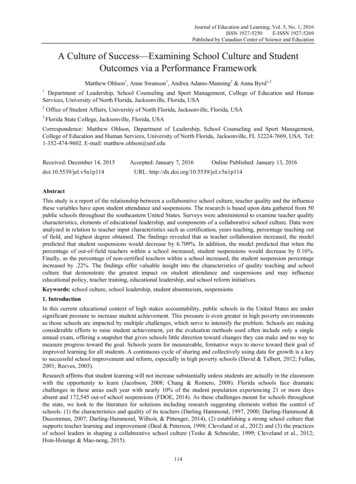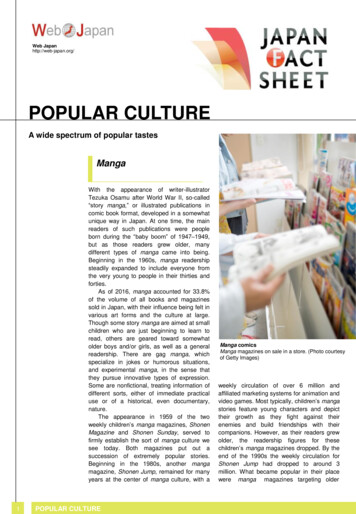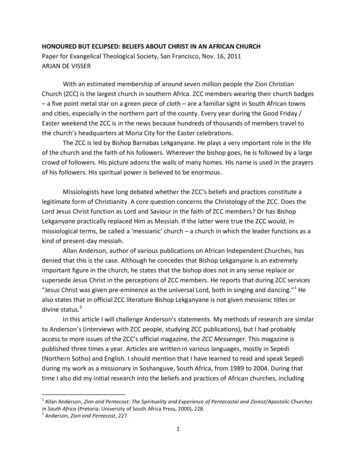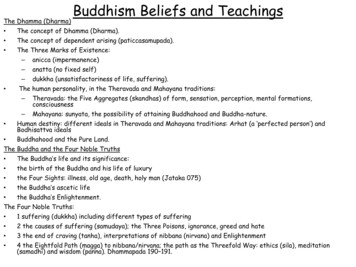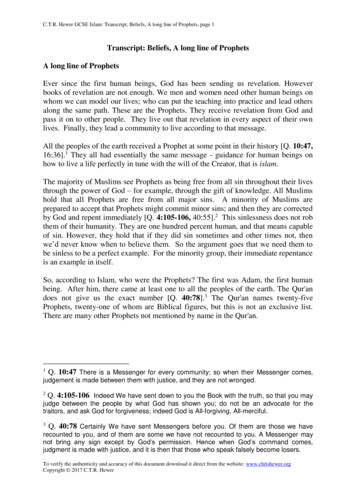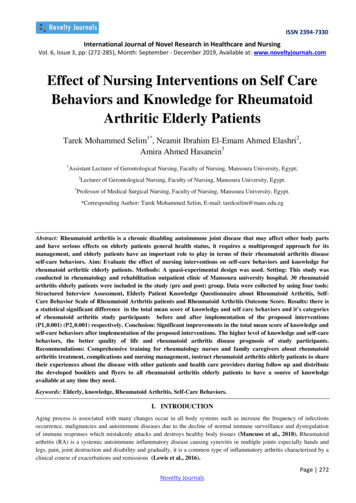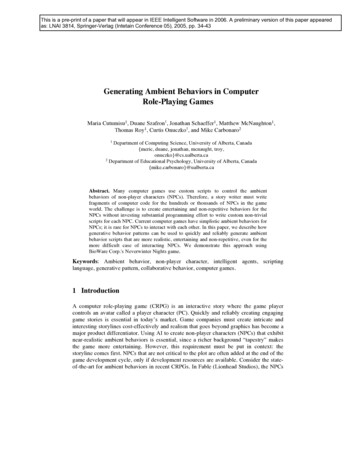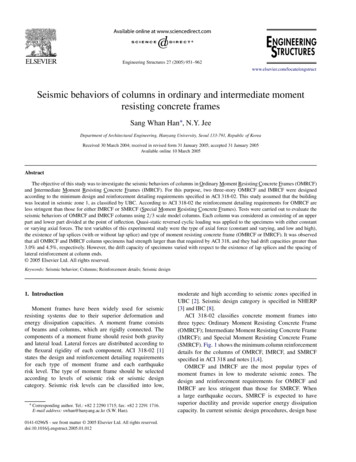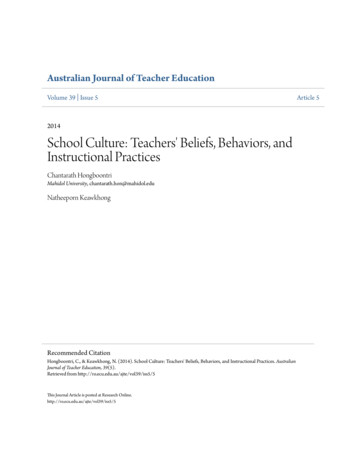
Transcription
Australian Journal of Teacher EducationVolume 39 Issue 52014School Culture: Teachers' Beliefs, Behaviors, andInstructional PracticesChantarath HongboontriMahidol University, chantarath.hon@mahidol.eduNatheeporn KeawkhongRecommended CitationHongboontri, C., & Keawkhong, N. (2014). School Culture: Teachers' Beliefs, Behaviors, and Instructional Practices. AustralianJournal of Teacher Education, 39(5).Retrieved from http://ro.ecu.edu.au/ajte/vol39/iss5/5This Journal Article is posted at Research le 5
Australian Journal of Teacher EducationSchool Culture: Teachers’ Beliefs, Behaviours, and Instructional PracticesChantarath HongboontriNatheeporn KeawkhongMahidol University, ThailandAbstract: This mixed-methods research project documents the schoolculture of Hope University’s Language Institute and reveals thereciprocal relationship between the school culture and the instructionalpractices of the English as a foreign language (EFL) teachers in thisparticular institute. Altogether, 62 EFL teachers agreed to complete aquestionnaire. Of these, 14 participated in semi-structured interviewsand classroom observations; 2 agreed to be interviewed but did not allowtheir classrooms to be observed. Quantitative data demonstrated strongcorrelations among eight social organizational variables of a schoolculture. Qualitative data further revealed the influences of a schoolculture on these teacher participants’ instructional practices.IntroductionSchool cultures are unique and distinctive. They are created and re-created by peopleconsidered members of a context; i.e., teachers, students, parents, and communities, among manyothers. Deal and Peterson (1999) defined that school cultures as a collection of “traditions andrituals that have been built up over time as teachers, students, parents, and administrators worktogether and deal with crises and accomplishments” (p. 4).School cultures are influential. They shape and re-shape what people do, think, and feel(Beaudoin & Taylor, 2004; Cooper, 1988; Craig, 2009; Deal & Peterson, 1999, 2009; Guise,2009; Hongboontri, 2003; Hongboontri & Chaokongjakra, 2011; Jurasaite-Harbinson & Rex,2010; Kleinsasser, 1993, 2013; Lieberman, 1988, 1990; Maslowski, 2001; McLaughlin, 1993;Muhammad, 2009; Rosenholtz, 1991; Sato & Kleinsasser, 2004; Schien, 2010). Rosenholtz’s(1991) quantitative and qualitative study of elementary school teachers in America convincinglydemonstrated how school cultures molded these teachers. With data gathered from 1,213completed questionnaires and 74 interviews, Rosenholtz identified two types of school cultures;i.e., nonroutine/certain and routine/uncertain. In the nonroutine/certain environment, teachersworked collaboratively, were involved in goal setting, and had opportunities for professionaldevelopment. These, in turn, maximized students’ academic growth. In contrast, teachers in theroutine/uncertain environment worked in isolation, had little (or almost no) involvement inschool goal setting, and had fewer opportunities for professional development. Students’performances were, as a consequence, minimized.The influences of school cultures on teachers have also been extensively covered in thefield of foreign language (FL) education. Kleinsasser’s (1993) findings of his triangulated studywith 37 FL teachers in five school districts in America emphasized the power of school cultures.Similar to Rosenholtz (1991), Kleinsasser found two types of school cultures: nonroutine/certainVol 39, 5, May 201466
Australian Journal of Teacher Educationand routine/uncertain. The nonroutine/certain culture promoted, Kleinsasser explained further,collaboration within a community. In other words, his participating FL teachers collaborated notonly with their colleagues in the FL department but they also worked with teachers from othersubject disciplines, students, parents, administrators, and communities. Through collaboration,these FL teachers could create a successful learning environment where their students had theopportunity to use the second language for communication. On the contrary, in theroutine/uncertain culture where collaboration was scarce (or almost nonexistent), the FL teachersnot only individually planned their own instructions but also pursued different goals of teachingand learning. Classroom instructions were mostly text driven and focused largely on grammar;students had little (or almost no) opportunity to use the second language for communication.Several years later, two doctoral students of Kleinsasser similarly investigated the schoolcultures in two different learning contexts (Japan and Thailand). Their findings echoed those ofKleinsasser (1993) despite their differences in the study contexts and the nature of the researchparticipants. Sato’s (2000) triangulated study of 19 English as a foreign language (EFL) teachersin one high school in Japan revealed the presence of a routine/uncertain school culture. In thisparticular high school, collaboration was scant; these participating teachers worked in isolation.Their instructions followed the content in the textbooks to prepare students for the exams.Interaction between teachers and students and among students themselves was limited; seatworkexercises and rote-learning activities were oftentimes implemented in EFL classrooms. (See alsoKleinsasser & Sato, 2007 and Sato & Kleinsasser, 2004 for more details.) Hongboontri (2003)went into one Thai university to document its school culture. By triangulating his gathered data,Hongboontri identified the existence of a routine/uncertain culture within this particularuniversity. These teachers admitted that they rarely collaborated with other teachers; they had noshared goals, and their learning opportunities were meager. Because of these factors, theirinstructions not only adhered to the assigned textbooks but also mainly emphasized discretegrammar points. Classroom interaction was rare as students were oftentimes individuallyinvolved with their grammar-oriented seatwork exercises. Hence, students’ opportunity to useEnglish for communication was nonexistent. (See also Hongboontri, 2006a, 2006b, 2007, 2008.)Studies of Kleinsasser (1993), Sato (2000 [also Kleinsasser & Sato, 2007 and Sato &Kleinsasser, 2004]), and Hongboontri (2003) offered some insights into the influential roles ofschool cultures on FL and EFL teachers. Nevertheless, more studies are still needed tounderstand the complexities of school cultures and their reciprocal relationship with FL and EFLteachers’ beliefs, behaviors, and instructional practices. Kleinsasser and Sato’s (2007) quotationwas worth mentioning despite its length.With these ideas of practice and professional development in mind we need toencourage further study of participants, contexts, professional development. We alsoneed to make sure that future studies qualify terms that adequately and adroitlysituate people, places, and their participant(s) in practice. Such ideas proffer furtherinquiry. What practices promote enduring language learning environments? Whatpractices constrain enduring language learning environments? How many authenticcontexts are there? How can authentic contexts be categorized, if at all? What arethe practices of administrators, teachers, students, parents, and other communitymembers in one context? How do such practices interact, evolve, devolve, or remainconstant? These and other issues require our attention at the dawn of the 21st century.We have only started scratching the surface. (p. 140)Vol 39, 5, May 201467
Australian Journal of Teacher EducationIn response to Kleinsasser and Sato’s (2007) call, this research study sought answers to tworesearch questions. (1) What pattern of school cultures is practiced at Hope University’sLanguage Institute? (2) What effects do school cultures have on EFL teachers at HopeUniversity’s Language Institute in terms of their instructional practices? This research wasgrounded upon two distinct theoretical notions on school cultures (Rosenholtz, 1991) and socialorganization (Thompson, 2010).Conceptual FrameworkTeachers are shaped by school cultures that they themselves might possibly have helpedshape. Rosenholtz (1991) asserted, “Teachers, like members of most organizations, shape theirbeliefs and actions largely in conformance with the structures, policies, and traditions of theworkaday world around them” (pp. 2-3). Thus, what teachers decide to do or not to do in theirclassrooms could be determined by teachers’ association with their school cultures such asschool policies, school traditions, school structures, and teacher interactions, among others(Bidwell & Kasarda, 1980; Hargreaves, 1994).Thus, to better understand school cultures and the reciprocal relationships between schoolcultures and teachers’ beliefs, behaviors, and instructional practices, teachers’ perceptions oftheir social organizations need to be examined. Rosenholtz (1991) suggested; “To understandschools, we must understand them as teachers do, that is, we must attempt to construe howschools appear to teachers who inhabit them” (p. 3). More important, teachers’ sharedunderstandings of their school cultures need to be garnered and uncovered. Citing Berger andLuckmann (1966), Rosenholtz contended;People come to define their workday realities through a set of shared assumptionabout appropriate attitudes and behaviors constructed within them. Meanings ofwork are exchanged, negotiated, and modified through the communications peoplehave with, or the observations they make of, others. Thus teachers learn througheveryday interactions how to name and classify things, and in that process learn howthey are expected to behave with reference to those things. (p. 3)The social organization of schools comprises of nine social organizational variablesincluding: (1) teacher certainty, (2) teacher cohesiveness, (3) teacher collaboration, (4) teachercomplaints, (5) teacher evaluation, (6) faculty goal setting, (7) managing student behavior, (8)parent involvement, and (9) teacher learning opportunities. (See Table I for their definitions.)These social organizational variables are, Rosenholtz (1991) argued, “not characteristics ofindividual teachers but that teachers have helped to shape; social organizations that then haveconsequences for teachers’ perceptions and behaviors” (p. 4). Teachers’ perceptions of thesevariables on the whole portray teachers’ understandings of their organizations; that is, how they“define the nature of their work, their sentiments toward their work, [and] the substance of theirwork” (Italics added, Rosenholtz, p. 3).Hence, it suffices to argue that the correlations among these social organizational variablesalong with teachers’ shared definitions of the variables as such help define school cultures. Inaddition, they sufficiently help sketch teachers’ patterns of beliefs and behaviors in schools anddepict the reciprocity between school cultures and teachers’ beliefs, behaviors, and instructionalpractices. Similarly, Thompson (2010) maintained,Vol 39, 5, May 201468
Australian Journal of Teacher Education[This] allows us to search in two distinctions, in the individual and in hisenvironment, for sources of diversity and uniformity. To the extent that individualsbring similar aspirations, beliefs, and standards into situations appearing to offersimilar opportunities and constraints, we can expect to find similarities or patterns inthe ensuing action. We now need to explore the extent to which categories ofindividuals are similarly programmed, and situations in complex organizations aresimilarly structured. (p. 102)Social Organizational VariablesTeacher certaintyTeacher cohesivenessTeacher collaborationTeacher complaintsTeacher evaluationFaculty goal settingManaging student behaviorParent involvement*Teacher learning opportunitiesDefinitionsThis variable focuses on teachers’ certainty of theirinstructional practices and the relationship between schoolcultures and teachers’ instructional practices.This variable investigates teachers’ sense of belonging bymeasuring the degree to which teachers feel they are partof their organization.This variable reveals teachers’ perceptions toward sharedwork and explores how collaboration is promoted ordeferred within a school culture while further measuringthe extent to which teachers are willing to work togetherto improve and solve instructional problems.This variable examines which types of teaching relatedactivities and extracurricular activities with which teachersare dissatisfied.This variable uncovers teachers’ feelings toward the waysthey are being monitored and evaluated.This variable measures the extent to which teachers areinvolved in their organization’s goal setting.This variable reveals teachers’ overall consistency inenforcing the rules for student conduct on students in theirorganization.This variable examines the extent to which parents areinvolved in their children’s learning.This variable measures the degree to which teachers aregiven opportunities to improve themselves. Also itexamines the extent to which a school facilitates orhinders teachers’ professional development.*It needs to be noted here that as the current study aimed to study school cultures at the tertiary level of education, parentinvolvement variable was then excluded. This is because at the tertiary level of education, parent involvement in the teachingand learning process is often minimized (or usually absent).Table I: Social rganizational variables and their definitionsTo understand what organizations do and how organizations behave, there is a need to,Thompson (2010) maintained, understand how individuals within organizations act or behave.This is because human action emerges, Thompson further argued, from his/her interaction of “(1)the individual, who brings aspirations, standards, and knowledge on beliefs about causation; and(2) the situation, which presents opportunities and constraints. Interaction of the individual andVol 39, 5, May 201469
Australian Journal of Teacher Educationthe situation is mediated by his perceptions or cognitions” (Italics original, Thompson, 2010, pp.101-102).Mode of InquiryFollowing the theoretical notions of a mixed-methods research paradigm (e.g., Dörnyei,2008; Tashakkori & Teddlie, 2010), the researchers of the present study employed four datacollection strategies to gather data. They were: (1) a questionnaire, (2) semi-structuredinterviews, (3) classroom observations, and (4) written documents and artifacts.The questionnaireThe questionnaire had 102 five-Likert Scale items (adapted from Hongboontri 2005;Kleinsasser, 1993; and Rosenholtz, 1991). Before its actual use, the questionnaire was piloted ona group of 10 university EFL teachers from Trust University (a pseudonym). Responses from thereturned questionnaires were entered into SPSS to calculate for the reliability. The questionnairehas the reliability of 0.977. (Preferably, the reliability should be, as Bryman & Carmer [1990]suggested, at or over 0.70.)Semi-structured interviewsThe researchers closely followed Spradley’s (1979) notions of ethnographic interview andoriginally developed 35 interview questions. These questions were tested with two universityEFL teachers and were then re-written, reworded, and rearranged. Finally, 24 open-endedquestions were used for the interviews. Each interview lasted approximately one hour dependingon the informant’s responses. With permission from the teacher participants, all interviews andfield-notes were recorded and taken. These were later transcribed for further analyses.Classroom observationsEach teacher who agreed to classroom observations was observed at least three times(Adler & Adler, 1994; Delamont, 2002; Denzin & Lincoln, 2010; Merriam, 1991). Duringclassroom observations, field-notes were kept and recorded in a classroom observation protocoladopted from Hongboontri (2005).Written documents and artifactsThroughout the duration of the data collection process (one academic year 2011-2012),written documents and artifacts (e.g., course syllabi, teaching materials, and pictures) werecollected.Participants and Data Collection ParticipationVol 39, 5, May 201470
Australian Journal of Teacher EducationAltogether 62 EFL teachers from three campuses of Hope University’s Language Institutevolunteered to complete a questionnaire. (The Language Institute of Hope University has threecampuses. The two main campuses are situated in Bangkok and in the outskirts of Bangkok; theother campus is in the northern part of Thailand.) Of these 62, 14 (12 Thais, one American, andone Irish) participated in both interviews and classroom observations; 2 Thais agreed to beinterviewed but dissented to classroom observations. (See Table II for further Applied LinguisticsInternational PolicyStudiesTEFLApplied LinguisticsApplied Linguistics andEconomicsTESOLTESOLApplied LinguisticsEnglish LanguageTeachingApplied LinguisticsEnglish and MusicTESOLInstructional andCurricular StudiesApplied LinguisticsData Collection ProceduresInterviewsClassroomObservations1st2nd3rd *Both Garry and Sean were native English speaking teachers (NESTs). Garry was from America and Sean came fromIreland.** Joseph, Kathy, and Ned taught at other campus of Hope University’s Language Institute.Table 2: Teachers’ participation in the data collectionEthical ConsiderationsEisner and Peshkin (1990) emphasized the necessity for a researcher to assure his/herresearch participants of their rights and their privacy. Mindful of this, the researchers of thepresent study first sent a letter to the Director of Hope University’s Language Institute requestingpermission to conduct a study. Once permission was granted, the researchers sent a letter alongwith a participant consent form to each individual teacher informing the teachers of the researchstudy, the data collection methods used in the study, and their rights either to participate and toVol 39, 5, May 201471
Australian Journal of Teacher Educationwithdraw from the study at any time or not to participate at all. More importantly, the letterensured the teachers that their confidentiality and privacy would at all times be protected.Data AnalysisResponses from the completed and returned questionnaires were tallied, tabulated, andentered into the SPSS program for correlation evaluation. Transcripts (and field-notes) frominterviews and classroom observation field-notes were analyzed with Strauss and Corbin’s(1998) open and axial coding techniques. With the ideas of open coding, interview andclassroom observation data were first read and re-read to identify similarities and differencesbetween responses and observation field-notes. These responses and field-notes were thenlabeled and grouped to form tentative categories. Following the concepts of axial codingtechniques, these tentative categories were re-organized moving from more general ones tocreate more related and meaningful groups of data. In other words, data were put back togetherby making connections between categories and sub-categories in light of conditions, contexts,action/interactional strategies, and consequences.Moreover, the researchers, adhering to the notions of triangulation (Kane, Sandretto, &Heath, 2002; Mathison, 1988; Metz, 2000), put the statistical data, the interviews, the classroomobservations, and the written documents and artifacts together in terms of consistency,inconsistency, or contradictory within these three data sets. Through this process, better insightsinto the culture of Hope University’s Language Institute and its reciprocity in this particularcontext would eventually emerge.ResultsThe statistical calculation of the 62 completed and returned questionnaires demonstratedstrong correlations among all eight social organizational variables. These strong correlationsindicated the parallel movement of the variables (Brown, 2005; Hatch & Farhady, 1982). Whatthis meant was, for example, the more these teacher participants collaborated in teacherevaluation and faculty goal setting, the more these teachers would be certain with theirinstructional practices. Not only that, the higher teacher collaboration could also open moreavenues for teacher professional development. On the contrary, the less these teachers interactedwith one another; the less they shared information and exchanged assistance; the less theyimproved themselves and their teaching. As a consequence, these teacher participants becameuncertain with their instructional practices. Worse yet, as these teachers had little (or almost no)involvement in faculty goal setting, they felt marginalized and that they did not belong to theirown working context. (See Table III for more details.)The strong correlations among these eight social organizational variables prompted thenecessity for further and closer investigation into how these teacher participants describedteacher collaboration within their Institute, how much they were involved in their Institute’s goalsetting process, and how they perceived their learning opportunities within this particularworkplace, among many others. An analysis of our qualitative data (interviews, classroomobservations, and written documents and artifacts) would allow us to offer and enhance a morecomplete picture of the pattern of the workplace culture and its reciprocity with these teacherparticipants’ beliefs, behaviors, and instructional practices.Vol 39, 5, May 201472
Australian Journal of Teacher 57**.650**56.6129 2 16.74369.659**.806**.832**.622**.882**51.5806 **.722**.893**19.08067.91823.725**.920**34.1935 13.60429.690**26.5161345678MeanS.D.5.3431234.1774 13.80369**Correlation is significant at the 0.01 level (2-tailed).Notes: 1 teacher certainty2 teacher cohesiveness3 teacher collaboration4 teacher complaints5 teacher evaluation6 faculty goal setting7 managing student behavior8 teacher learning opportunitiesS.D. standard deviationTable 3: Correlations, means, and standard deviations for social organizational variablesThe Culture of Hope University’s Language Institute and Teachers’ Beliefs, Behaviors, and InstructionalPracticesIn this section, our analysis of the qualitative data garnered from interviews, classroomobservations, and written documents and artifacts offered deeper insights into the reciprocalrelationships between the Language Institute’s culture and its teachers’ beliefs, behaviors, andinstructional practices in terms of the eight social organizational variables. Such insights offereda more informed portrait of the Language Institute’s culture and its influences on the teachers.School Culture and Teacher CollaborationWhen asked to describe their working cultures in this organization, the teachers in Bangkokcampuses expressively admitted that they scarcely collaborated with their colleagues. Eventhough the Language Institute promoted co-teaching policy, especially between native and nonnative English speaking teachers, most teachers still preferred to work either individually orbalkanizedly. One native English speaking teacher (NEST), Sean, who had been teaching in thisInstitute for about one and a half years, rather isolated himself and desired to work individually.He noticed that his workplace was formed with different cliques. As a consequence, heperceived working in teams in this organization as a failure. Sean said;I work with my colleagues as little as possible. I’m quite individualistic. We kind offormulate teams and groups, but the end of the day, I still think the teachers are solargely single. I don’t like working in teams. I find it irritating. I find it quite hard tonegotiate things in the way that I would like. I either dominate or else I let otherVol 39, 5, May 201473
Australian Journal of Teacher Educationpeople do it their way. Reaching compromise is a really tough thing to do with agroup of people. That’s the honest answer. I think accentually many teachers arequite solitary adults. I wouldn’t say that we have a close functioning working orsystematic way of working together. We find it hard to work together. (Sean)When Sean needed help with his instruction, he opted for the Internet. What he sharedwith the colleagues he was close with was limited to student difficulties or organizationalmanagement.I don’t like to admit that I have challenges in my class. It’s very rarely that Iapproach anybody directly for advice. I use the Internet a lot to look at lesson plansfrom different institutions and then compare them with the way I do. However, if I’mfrustrated with the class, I’ll vent my frustration out with the group of teachers thatI’m quite close to. Things like, ‘Oh! My God, what’s going on with these students?What’s going on with the exam? It’s too difficult for them.’ (Sean)Sean’s practice of individualism affected his teaching in various ways. Observations in hisclassroom showed that his teaching was oftentimes unorganized. Sean implemented a number ofclassroom activities in his teaching. Nonetheless, these activities had neither clear purposes norinstructions. Students most of the time appeared confused and barely participated in Sean’sactivities. Sean dominated his classrooms by asking and answering his own questions andrunning those activities himself. He often drilled students with vocabulary that popped-upduring class or unfamiliar vocabulary; he rarely gave comments to students’ presentations. Hisclasses eventually remained puzzling.During an interview, Rene, a novice Thai EFL teacher, described how lack of teachercollaboration within the Institute had affected her teaching. As a new teacher, she receivedneither guidance nor assistance from her colleagues. As a consequence, she had vague ideasparticularly on how to approach the assigned curriculum and the textbook. Rene lamented,When I first started four months ago, I had no idea of whom to go to when I hadteaching problems. I was alone at the crossroads. The Institute gave me threesections to teach and ‘This is the book; go and teach’. That’s it. No one shared mewhat to do. I was even more confused when I found that some teachers used the bookand some didn’t. Some skipped those chapters in the book and supplemented a lot. Ithought we were meant to follow the book. Everybody seemed to be confused. Thismight be because we were changing the curriculum. I, however, didn’t care muchhow the curriculum had changed. But I DID care how I should start my teaching.(Rene)Teacher isolation was witnessed not only in the Bangkok campuses, but was alsoubiquitous in the Institute’s northern campus. This campus had three Thai EFL teachers. Two(Ned and Joseph) formed a group and singled out another teacher (Kathy) who had beenrecruited only a few months before the commencement of this research study. Ned and Josephgot on well together as they shared not only similar teaching goals but also perceptions of theirstudents. For example, both Ned and Joseph focused on preparing students for examinations.They covered every content and grammar point in the in-house textbook as they would be inquizzes and exams. They considered their students as low-proficient and had low expectationsof students. The goals of language teaching and learning of the newly recruited teacher, Kathy,were different from those of Ned and Joseph. Her goals were to foster communicativecompetence within these students. With such goals, she had high expectations of her students.She assigned students a number of outside-classroom activities for self-study such as watchingVol 39, 5, May 201474
Australian Journal of Teacher EducationEnglish-soundtrack films or having conversations with native English speakers. These teachers’different goals of teaching and learning caused conflicts among them and finally closed the doorfor teacher collaboration. During an interview, Ned described his exchange of assistance andteaching materials with Joseph this way. “We shared teaching problems, teaching materials,exchange tips, and so on.” Ned, however, admitted a division between him and Kathy. As such,the division was generated by, Ned complained, Kathy’s “attitude problems.She’s very demanding and pushy. Students have been complaining about her. Shegave students loads and loads of assignments. We told her in the meeting to cutsome; she wasn’t very happy and showed her dissatisfaction. (Ned)Ned had as little contact with Kathy as possible. At worst, he even considered leaving his job.Her demanding attitude just got me. I don’t quite talk to her. I completely separatemyself from her. I only work with her if necessary. Successfully, she has managedto kill the environment. I have been thinking about leaving the job. (Ned)Kathy’s high expectations of the students once concerned Joseph. Having been assigned tomentor these two teachers, Joseph told Kathy to lower her expectations and to lessen herassignments. Kathy, however, insisted on keeping those expectations. Joseph recalled, “Kathyhad too high expectations of her students. I told her to lower her expectations as these studentsare weak students. For example, if she assigned 20 assignments, I told her to lower that. But shedidn’t. She gave all those 20 assignments. It didn’t work.” Since then, Joseph distancedhimself from Kathy and rarely offered her any advice. “I don’t tell her directly that what sheplanned is not gonna work. I let her do whatever she planned. Her students would eventuallytell her that this is not working.”Kathy was aware of her two collea
Abstract: This mixed-methods research project documents the school culture of Hope University’s Language Institute and reveals the reciprocal relationship between the school culture and the instructional practices of the English as a foreign language (EFL) teachers in this particular in
